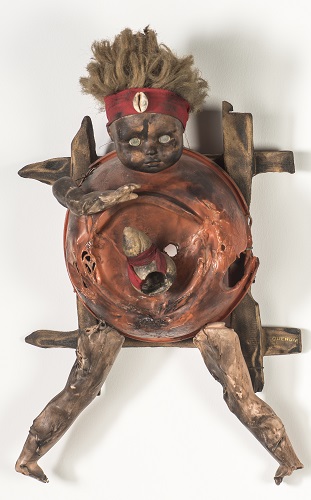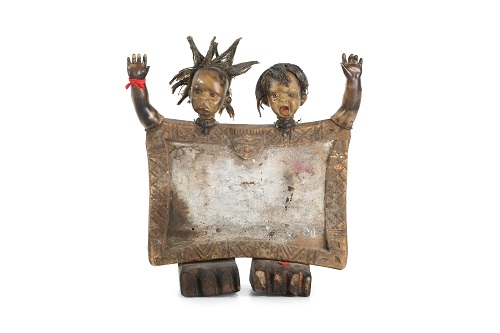Quenum, Gérard
Benin, 1971
Born 1971, in Benin. Lives and works in Porto-Novo, Benin.
Gérard Quenum is both a painter and a sculptor. His work is mesmerizing – filled with meaning, it invites us to stop and wonder.
On large canvases, Quenum paints with acrylics one, two or three solitary characters against a seemingly plain white background. The colors are primary – blue, red and yellow – and black. The characters are not detailed; they are suggested, caught in mid movement…walking, pushing a cart, ready to climb stairs, or turning around to stare at someone or something. They may seem alone, until you realize that they are not. People, movement, noise surround them. The negative space is as alive as the positive one.
Quenum’s sculptures are completely different – and they all have one thing in common: discarded dolls. Quenum found his first doll in the mud of a rainy day more than twenty years ago. He has since retrieved dolls from rooftops, the street, and the bush. He sees in each one the story of a child, “the suffering of a family, of Africa, of humanity.” Pairing them with other repurposed objects, Quenum gives the dolls new life in sculptures reminiscent of bocio – carved wooden figures, adorned with sacred materials (e.g., animal skulls, claws, feathers) and encrusted with clay, palm oil or sacrificial blood. Bocio are considered mediators with the spirit world in Voodoo, the official religion of Benin and one of the two religions Quenum grew up in.
Quenum is self-taught. In the late 90s, he worked alongside other artists in a group, led by Dominique Zinkpè, that organized spontaneous guerrilla exhibitions – called “Boulev’art” – on the streets of Cotonou and Porto-Novo. It was there that he was discovered and propelled onto the international art scene. Today, Quenum’s art is in the British Museum, the Museum Afro-Brasil of São Paolo (Brazil), the Afrika Museum (Netherlands), as well as many other museums, galleries, and collections around the world


